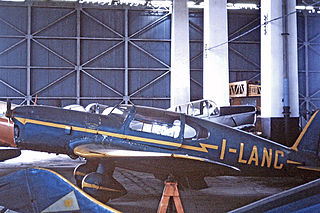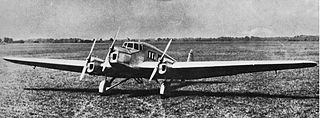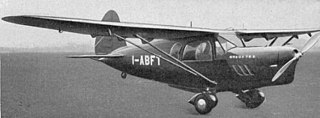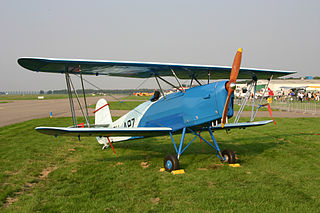
The Ambrosini SAI.7 was an Italian racing aircraft flown before World War II that entered production as a military trainer after the war. It was of conventional configuration, constructed of wood, with a tail wheel undercarriage. Power was provided by an air-cooled inverted inline engine, the Alfa-Romeo model 115 with 225 horsepower.

The Ambrosini SAI.2S was a four-seat light aircraft produced in Italy shortly before World War II.
The Praga BH-111 was a sportsplane of Czechoslovakia, designed and built specifically to compete in Challenge 1932, the European touring plane championships. It was a two-seater low-wing monoplane.

The Fiat G.2 was an Italian three-engine six-passenger monoplane transport aircraft designed by Giuseppe Gabrielli and built by Fiat.
The Miles Merchantman was a scaled-up and four-engined development of the Miles Aerovan light freighter. It flew in 1947 but the design was abandoned when Miles Aircraft was taken over by Handley Page in 1948.

The Breda Ba.79S was a single-engine four-seat high-wing private aircraft built in Italy in the late 1930s. Only a few were produced.

The CANT Z.1012 was a small three-engined monoplane built in Italy in the late 1930s to carry either three or five passengers depending on the engines. A small number were built for Italian diplomatic use.

The IAR-22 was a single engine basic trainer built in Romania in about 1934. It was a low-wing monoplane with two seats in tandem and a fixed conventional undercarriage.
The Moskalyev SAM-14 was a late 1930s Soviet, five-passenger transport, one of a series of developments of the successful Moskalyev SAM-5.

The Bernard 200 T was the first of a series of French light touring aircraft from the early 1930s. Single engined and seating three or four, they were high cantilever wing monoplanes. Four Bernard 200 T were built and subsequently modified into three further variants.

The CANT Z.515 was a twin engine monoplane floatplane designed and built for maritime reconnaissance in Italy at the start of World War II. It did not go into service.

The Pander P-1 and P-2 were close to-identical single engine Dutch sports aircraft with tandem seats and a parasol wing, first flying in 1929. Only two were built.
The Pander P-3 was a parasol wing, two seat, single engine sports aircraft designed in the Netherlands in the early 1930s. Only one was built.

The Koolhoven F.K.47 was a 1930s one-off two seat biplane designed and built in the Netherlands for an individual customer as a sport and touring aircraft.

The Koolhoven F.K.54 was a Dutch single-engine, three-seat touring aircraft with a retractable undercarriage. It flew shortly before the start of World War II and its development was abandoned after its first flight as attention turned to military aircraft.

The Lambach HL.II was a single seat aerobatic biplane designed and built in the Netherlands to provide Dutch pilots in a local, annual competition with their own machine. It proved no match for contemporary Germany aircraft.

The Aeronautica Lombarda AL-12P was a Second World War Italian transport glider built by the Aeronautica Lombarda for the Italian Army.
The Bloch MB.90 was the first all-metal French light aircraft. Only two aircraft were completed, making their first flights in 1932, though there were several variants.
The Curtiss-Reid Courier was designed in Canada in 1931 as a specialist, non-passenger carrying, mailplane capable of maintaining services in Canada's hard winters. The 1930s depression led to the end of government subsidised airmail contracts and only one prototype flew. It was lost in 1933 during preparations for a private, long distance flight.
The WT-1 was a 1931 high performance sports aircraft designed in Poland. It only made two flights.













